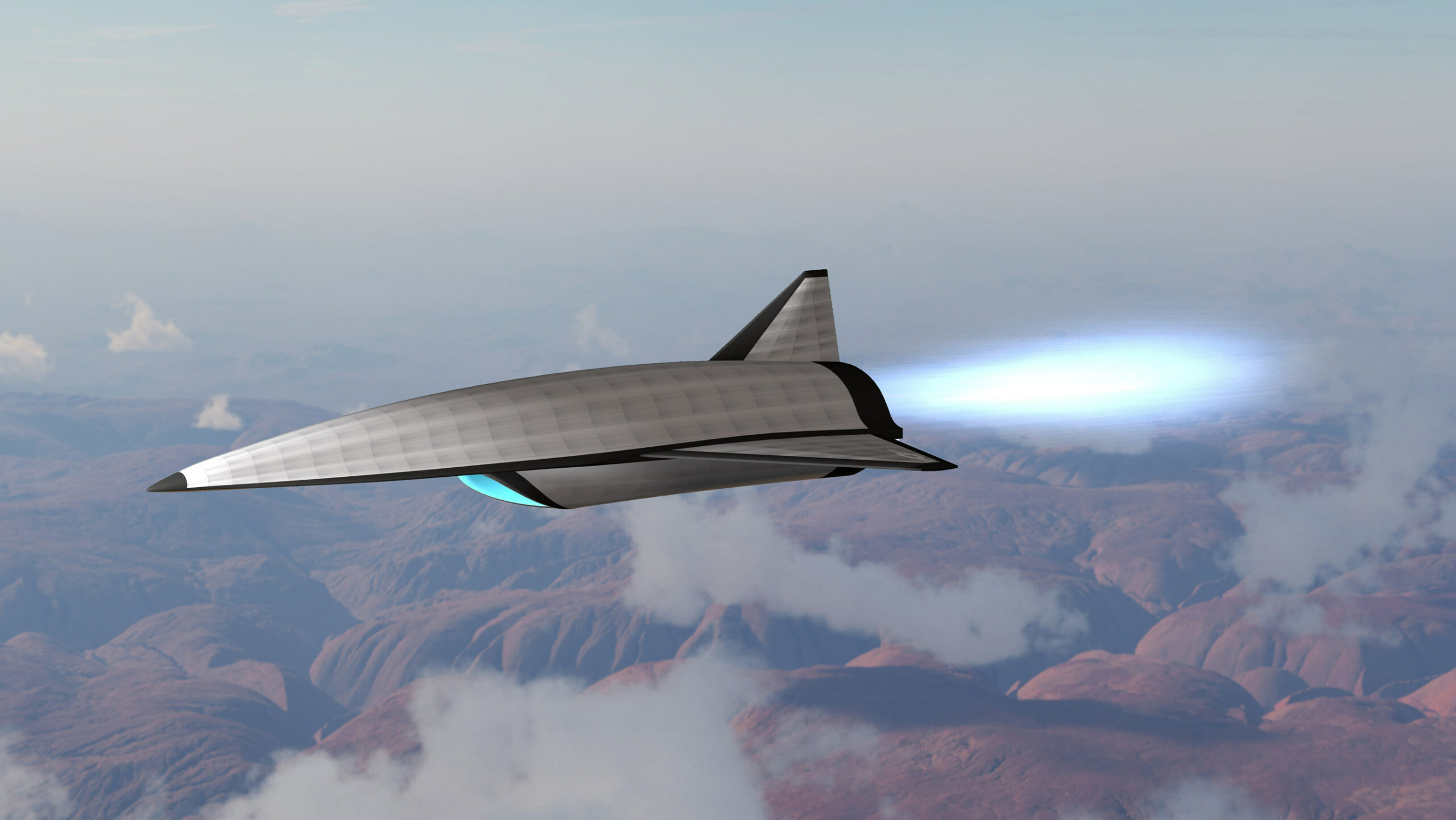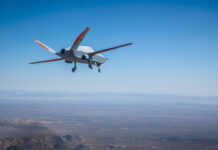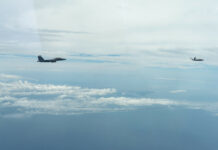‘Project Mayhem’ aims to provide the US Air Force with an unmanned hypersonic aircraft capable of both reconnaissance and strike missions.
The project’s official designation is Expendable Hypersonic Multi-Mission Intelligence, Surveillance, Reconnaissance and Strike. As the name states, the unmanned aircraft will be tasked with both reconnaissance and combat missions. As a hypersonic aerial vehicle it will be considerably more survivable than other manned or unmanned ISR systems, and will be able to provide situational awareness or targeting data much faster than conventionally-powered aircraft. As a strike platform, the aircraft will have a larger payload capacity than the hypersonic cruise missile concepts currently being developed by the US Air Force (USAF). In either mission mode ‘Mayhem’ is expected to enhance short-term response to fluid and developing tactical situations. Despite the inclusion of ‘Expendable’ in the weapon system’s name, the highly capable plane is not designated as a one-mission suicide drone. Rather, the term reflects the reality that the military will more readily send an unmanned aerial vehicle (UAV) on some high-risk missions, accepting the potential loss of the plane when the operational reward is high.
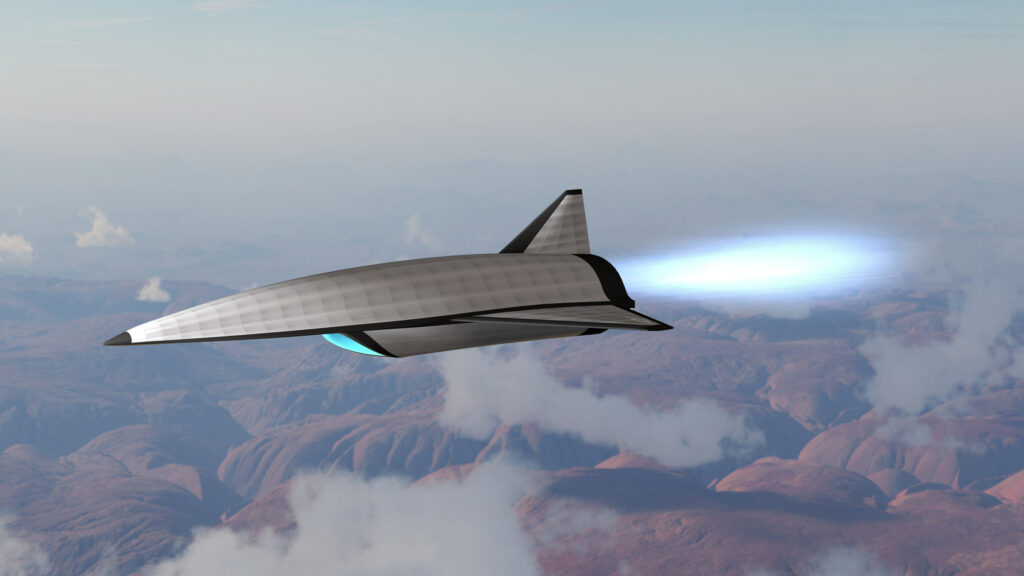
Credit: ARFL/Leidos
The existence of the program was first revealed publicly in August 2020, through an initial Request for Information (RFI) to industry. At the time it was designated the ‘Expendable Hypersonic Multi-Mission Air-Breathing Vehicle,’ with no specific mention of a mission profile. The current designation and the revelation of the dual mission configuration was announced in December 2021. Announcement of the program was followed by several additional RFIs, and a solicitation for offers was issued in March 2022. The latter ultimately led to the December 2022 award of the contract for design and systems development to Leidos Inc. as the prime contractor.
As stated in the April 2022 updated solicitation to industry: “The Mayhem Program is focused on delivering a larger class air-breathing hypersonic system capable of executing multiple missions with a standardised payload interface, providing a significant technological advancement and future capability. The standardised payload interface would create multiple opportunities for various payload integration within the same hypersonic system.”
Hypersonics 2.0
While the state of technological development is only now making operational hypersonic systems viable, the concept – and the aspiration – are not new. The USAF experimented with manned hypersonic aircraft as early as the 1960s. The current world speed record for manned powered flight was set on 3 October 1967 by then-Major William Knight in the X-15A-2, reaching 7,274 km/h or Mach 6.7. The North American X-15 was a rocket powered aircraft which was carried underwing by a B-52 bomber and launched at an altitude of circa 13,000-14,000 m. The rocket engine fired for a maximum of 120 seconds, propelling the aircraft to very high speeds, after which the pilot continued to conduct high-speed glide manoeuvres before landing via the retractable gear. Despite the impressive propulsion results, the experimental program was terminated in 1968 because of persistent technical and safety issues.
Interest in hypersonics continued. NASA built and tested three X-43 unmanned hypersonic aircraft in the 2001 to 2004 timeframe. The 3.7 m long aircraft were launched via B-52, and propelled to hypersonic speeds via a booster rocket. Following separation of the booster, an experimental scramjet engine ignited for circa 10 seconds. The third and final X-43 achieved Mach 9.68 on 16 November 2004. The X-43 was designed as a one-flight aircraft; all demonstrators were deliberately crashed into the Pacific Ocean following test flights.
The X-43’s primary purpose was to serve as a testbed for scramjet technology. The program was succeeded by the unmanned X-51 Waverider, which was also launched from a B-52 and brought to speed with the aid of a booster before firing the experimental scramjet engine. Four powered flight tests were conducted from 2010 to 2013, each ending a planned crash. Only the final test was considered a full success, achieving 210 seconds of propulsion from the scramjet engine, and reaching Mach 5.1 in the process. While progress was slow and limited, these preceding decades of experimentation did ultimately pave the way to today’s hypersonic programs.
Tactical Advantage
With all three major military powers – and several secondary powers – developing or at least researching hypersonic military systems, fielding this technology is taking on new urgency. To date Russia and China have been focussed on developing hypersonic glide vehicles as well as hypersonic cruise missiles. The United States armed forces are following suit, but are also interested in acquiring hypersonic aircraft. Project Mayhem seeks to develop technology in support of the latter goal.
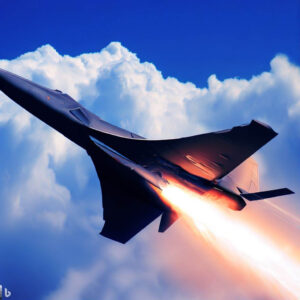
Credit: Sidney E. Dean (created with Bing Image Creator)
From an operational standpoint, a hypersonic ISR/Strike aircraft will provide commanders the ability to quickly update situational awareness, including locating high-value mobile targets and destroying them before they can relocate. A reusable hypersonic strike aircraft could effectively turn conventional air-to-ground bombs and missiles into hypersonic weapons by carrying them past enemy air defence networks and deploying them at ranges close to the target. The aircraft will also be able to react more flexibly if a programmed target has moved. Additionally, a hypersonic aircraft will be much better-suited than conventional supersonic aircraft to evade enemy air defence missiles.
Hypersonic aircraft would also have several advantages vis hypersonic missiles (including cruise missiles). The greatest advantage is the fact that they will, under most circumstances, return to base after a mission. Commanders will retain the asset more-or-less indefinitely (minus battlefield attrition), permitting multiple sorties per unit. In addition to improved readiness, a reusable aircraft would be considerably more cost-efficient than single-use hypersonic missiles. A 2021 Pentagon study found that the hypersonic missiles being developed for the Navy and Army could cost between USD 89.6 M and USD 106 M each, as much or more than an F-35 fighter aircraft; a 2023 report by the Congressional Budget Office assumes a unit cost of only USD 41 M, still a significant figure. This cost factor will limit availability. For example, the US Navy and Army together are planning to acquire only 300 hypersonic glide vehicle (HGV) weapons under their respective Conventional Prompt Strike and Long Range Hypersonic Weapon programs (even at USD 41 M per unit, this 300 missile tranche would cost as much as a Ford class aircraft carrier – which is capable of launching 300 sorties per day).
Capabilities Profile
Many details of the Mayhem program remain classified. The new system will be a large-class version that surpasses current developmental hypersonic systems in range and payload capacity. Mayhem’s technology will increase USAF’s ability to attack more distant or highly defended tactical targets, especially when they are time critical. The Air Force has also clearly stated that the objective aircraft will be unmanned, and (as a hypersonic system) be capable of a minimum Mach 5 airspeed. Some unofficial sources estimate airspeeds up to Mach 10.
A request for information (RFI) published by the Air Force on 14 December 2021 publicly revealed details which would indicate the objective capabilities profile and concept of operations. Previous RFI’s had already mentioned the need for a modular payload bay capable of accommodating a trio of payloads. The 14 December 2021 notice specified three distinct payload types needed to accomplish “three key mission goals”: an “area effect payload,” a “large unitary payload” and a “responsive” ISR payload. “The system goal is to carry payloads five times the mass and double the range of current technology capability systems,” the RFI stated. Although this data was specifically designated as “Controlled Unclassified Information,” a new RFI was published only three days later – on 17 December 2021 – omitting these details.
Propulsion Challenge
In order to achieve the anticipated speed and range objectives, Mayhem will most likely need to employ a scramjet engine as the primary propulsion system. Unlike conventional jet engines, which use internal fan blades to compress inflowing air before mixing it with fuel and igniting it, scramjets utilise the natural compression which occurs when air enters the engine at very high speeds, typically Mach 3 or higher. This enables them to achieve sustained hypersonic flight at significant range. Since the scramjet engine will normally not function properly at airspeeds below Mach 3, the aircraft is likely to require a combined-cycle propulsion system. This would combine a conventional high-performance jet or ramjet engine and a scramjet engine. In such a scenario, the conventional engine would be used to take off and to accelerate to supersonic speeds. When the plane meets the Mach 3 or higher range, the scramjet engine would fire up and accelerate to hypersonic speeds. The conventional engine would come into play again for controlled landing at the end of a mission.
Such technology is currently being pursued by the Department of Defense (DoD) as well as the aerospace industry. Creating a combined-cycle engine is considered a significant technological challenge. Even pure scramjets have yet to be fully developed. A successful free flight test of a US scramjet engine took place in 2021 as part of the DoD’s Hypersonic Attack Weapon Concept (HAWC) cruise missile program. Mayhem is expected to directly benefit from the hypersonic cruise missile research, but integrating conventional and scramjet engines faces the difficulty of not blocking airflow to the scramjet engine and also keeping weight within acceptable parameters. Lockheed Martin is known to have been researching this technology as part of the SR-72 program, which predates Project Mayhem, and also aspires to developing a hypersonic strike aircraft concept. However, to date no firm or agency has publicly acknowledged success in devising a combined-cycle engine.

Credit: Lockheed Martin
Although the focus remains on scramjet technology, there may be an alternative based on more mature technology. While it has not been publicly mentioned in connection with Project Mayhem, the firm Hermeus is developing a non-scramjet propulsion system capable of achieving hypersonic speed. Chimera is a turbine-based combined cycle engine (TBCC) which has been described as a hybrid between a turbojet and a ramjet. The transition to ramjet propulsion occurs between Mach 2 and Mach 3. Hermeus hopes to achieve sustained speeds of Mach 5 with the Chimera engine, and apply the technology to both civilian and military aircraft. The firm plans to utilise the TBCC on the Darkhorse unmanned aircraft demonstrator which it hopes to fly in 2025. The Darkhorse, which Hermeus is specifically designing for military and intelligence applications, is expected to achieve Mach 5.
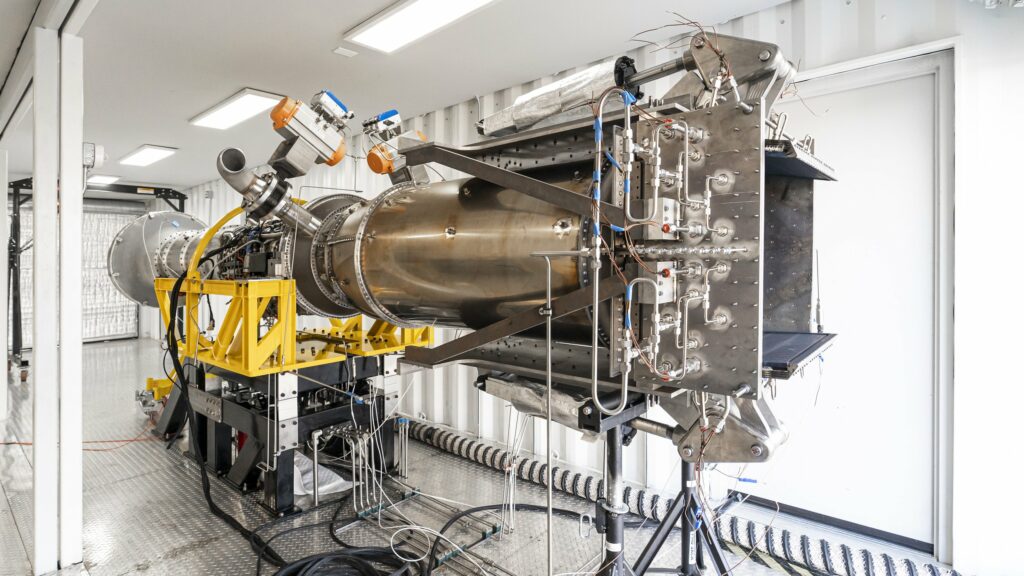
Credit: Hermeus
Contract Status
The contracting and lead development agency for the government is the Air Force Research Laboratory (AFRL). The competition for the system’s development contract was launched in March 2022 with publication of a broad agency announcement soliciting industry offers; given the sensitive nature of the project, the statement of objectives and the proposal requirements were only provided to industry on request. As defined by the Air Force, the development program is focussed on delivering a “larger class air-breathing hypersonic system capable of executing multiple missions with a standardised payload interface, providing a significant technological advancement and future capability.”
The government received six industry offers. On 16 December 2022, AFRL awarded Leidos Inc. an indefinite-delivery/indefinite-quantity, cost-plus-fixed-fee development contract for the Mayhem program. The award has a USD 334 M ceiling, and encompasses a 51 month period of performance, including a 45 month ordering period. The 51 month period of performance is divided into several phases. According to Leidos, the initial task order is valued at USD 24 M to conduct the System Requirements Review (SRR) and Conceptual Design Review (CoDR) in a Digital Engineering (DE) environment. This section of the project has a 15 month period of performance, divided into 12 months for technical effort and three months for completing the final reports.
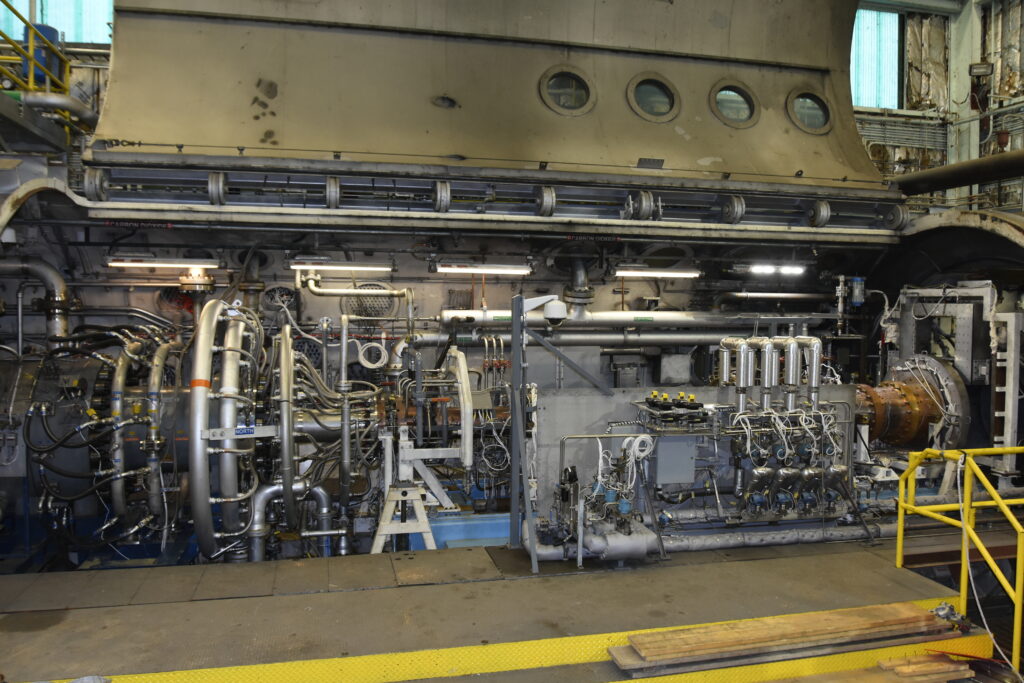
Credit: USAF
Leidos has in fact stated that it will apply digital engineering (DE) and model-based systems engineering (MSBE) throughout the design and development program, including the initial concept testing phase. This fits the recent trend in digital design and testing which is increasingly favoured by the Pentagon, as it can significantly shorten development timelines while reducing cost when compared to traditional design and development methods. The three firms, together with Leidos, will form the System Design Agent (SDA).
The SDA will be responsible for design efforts, prototyping and testing under the current contract, with the ultimate goal of producing and delivering a technical data package for high-performance hypersonic weapon systems. According to the AFRL’s series of RFIs as well as the corporate press releases, this package will encompass the entire integrated and functional vehicle system, to include an airframe, propulsion system, booster, avionics and vehicle subsystems. Work is to be performed at Wright-Patterson Air Force Base, Ohio, and other potential testing sites to be determined by the government. Work under the December 2022 contract is expected to be completed by 15 October 2028.
Sidney E. Dean


